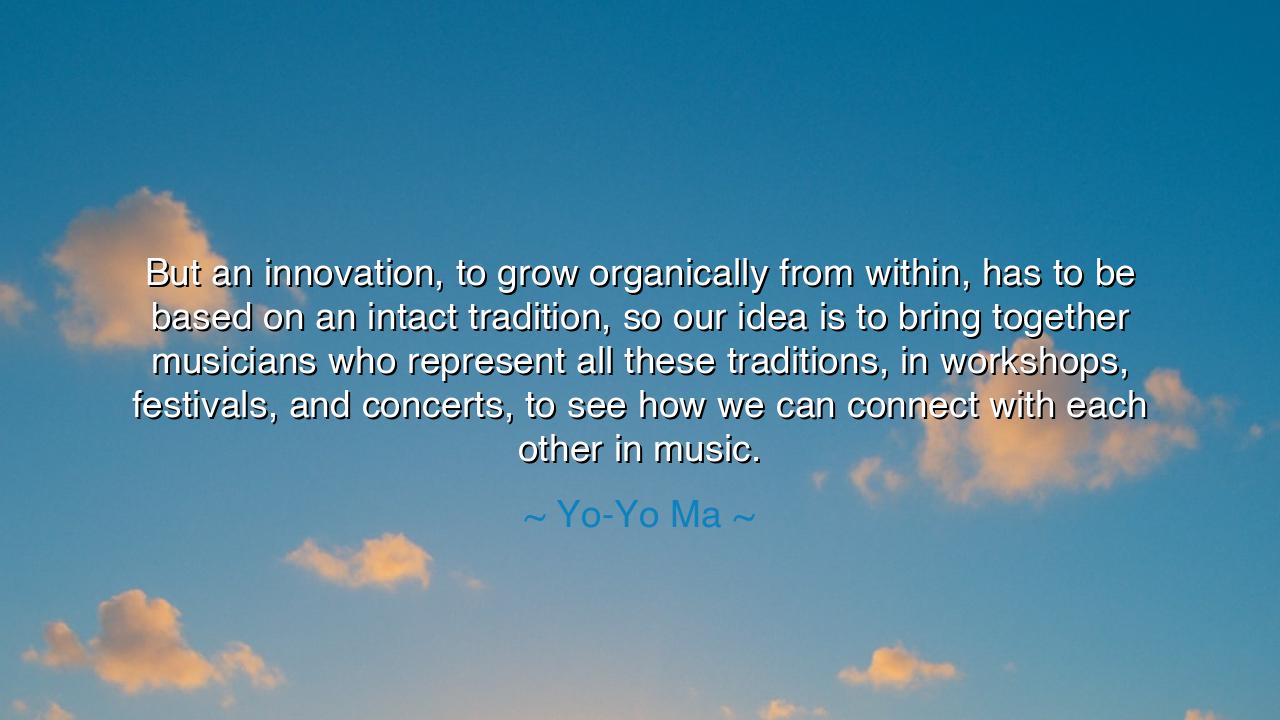
But an innovation, to grow organically from within, has to be
But an innovation, to grow organically from within, has to be based on an intact tradition, so our idea is to bring together musicians who represent all these traditions, in workshops, festivals, and concerts, to see how we can connect with each other in music.






Yo-Yo Ma, master of the cello and servant of harmony, once proclaimed: “But an innovation, to grow organically from within, has to be based on an intact tradition, so our idea is to bring together musicians who represent all these traditions, in workshops, festivals, and concerts, to see how we can connect with each other in music.” These words resound like a teaching from the ancients, for they remind us that the new is not born from nothing—it blossoms from roots. The tree of the future draws its strength from the soil of the past, and without deep roots, no branch can bear fruit.
The ancients themselves spoke of this union of past and future. The Greeks honored the Muses, guardians of memory, for they knew that to create new poetry, one must drink first from the well of old songs. In India, raga was not invented in a day, but shaped over centuries of devotion, each generation building upon the tones left by the one before. So too with every enduring art: it is tradition that gives innovation its strength. Yo-Yo Ma reminds us that what is intact must not be abandoned, but embraced, so that the new may grow without severing itself from the living root.
Consider his own creation, the Silk Road Ensemble. Yo-Yo Ma gathered artists from China, India, the Middle East, Europe, and beyond, each carrying their own tradition of sound. He did not seek to erase these traditions, nor to replace them, but to weave them together in dialogue. A Persian kamancheh spoke with a Chinese pipa; an Indian tabla conversed with a Western violin. From these meetings arose not chaos, but beauty: the discovery that each tradition, intact in itself, could become part of something greater. This was not forced fusion, but organic connection through mutual respect.
History itself gives witness to this truth. When jazz was born in New Orleans, it did not emerge from emptiness. It grew from the African rhythms preserved in Congo Square, the blues sung in sorrow, the European brass bands of the streets. Because the traditions were alive and intact, when they met, they birthed an innovation that reshaped the world. Had those roots been cut away, the flowering would not have come. Yo-Yo Ma’s words echo this same truth: protect the roots, and the branches will grow.
The meaning of his teaching is profound: the future cannot flourish by scorning the past. To innovate without tradition is to build castles in the sand—impressive for a moment, but swept away by the tide. To ground ourselves in tradition is not to be chained by it, but to give depth and power to our creations. For the past carries wisdom, memory, and spirit. When these are honored, the present may become fertile ground for something new.
The lesson for us, then, is both humbling and inspiring. If we would create—whether in art, in science, or in life—we must not despise what came before. We must learn it, preserve it, and let it shape us. Only then can our innovation be authentic, not shallow mimicry. At the same time, we must be open to dialogue, as Yo-Yo Ma gathers musicians from every culture, to listen and to learn from one another. For it is in connection, not isolation, that true breakthroughs are born.
Therefore, let each person practice this wisdom. Study the traditions of your craft deeply, not as lifeless history but as living soil. Respect the ways of those who came before, yet do not fear to bring forth your own voice. Seek out others, from different backgrounds, and find ways to connect—not to erase differences, but to let them shine in harmony. In this way, your work will carry both the depth of the past and the freshness of the new.
Thus Yo-Yo Ma’s words endure as a guide to all who create: “An innovation, to grow organically, must be based on an intact tradition… bring together musicians, and see how we can connect.” This is the eternal balance—roots and wings, memory and imagination, tradition and innovation. To live by it is to ensure that our creations will not only dazzle in the moment, but endure across the ages, carrying both the voice of the ancestors and the promise of the future.






AAdministratorAdministrator
Welcome, honored guests. Please leave a comment, we will respond soon